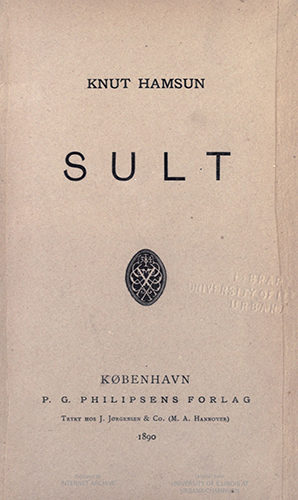56 Norwegian

Det var i den Tid, jeg gik omkring og sulted i Kristiania, denne forunderlige By, som ingen forlader, før han har faaet Mærker af den . . .
It was in those days when I wandered about hungry in Kristiania, that strange city which no one leaves before it has set its mark upon him . . . (trans. Sverre Lyngstad, 1996)
So opens Knut Hamsun’s novel, Sult (Hunger). When Sult was published in 1890, it represented a literary breakthrough not just in Scandinavia but also throughout Europe. Though Hamsun’s later novels would take more conventional forms, Sult was a harbinger of 20th century modernism for its stream-of-consciousness narration and its focalization of a vagabond figure who struggles to cope with modern urban life. The novel’s plot is spare: an unnamed — and unreliable — narrator arrives in Kristiania (now Oslo); he struggles to get work as a writer and has occasional run-ins with strangers; three months later, he leaves the city by boat. What makes the novel remarkable is how it portrays the inner life of a — literally — starving artist. Through the narrator’s increasingly wild musings, it is difficult for the reader to decipher whether the protagonist is insane or just hungry, and whether his hunger is forced upon him by poverty or voluntarily undertaken as part of a fascinating, yet ambiguous, creative project. As Hamsun put it elsewhere, Sult aims to reveal “the unconscious life of the soul.”1
Knut Hamsun is widely accepted as one of Norway’s greatest authors. He is second only to Henrik Ibsen in terms of international renown and he won the Nobel Prize for literature in 1920 for his novel Markens grøde (“Growth of the Soil”). However, his legacy has been hotly debated, and his reputation severely damaged, by his strong Nazi sympathies and support of the Nazi occupation of Norway (1940-45).
Though Sult was written in Norwegian, it is a Norwegian highly inflected by Danish spelling. For 400 years, Norway was under Danish rule, during which time Danish was the language of writing and instruction in Norway. After declaring independence from Denmark in 1814, Norwegians were eager to establish an official language that better reflected the range of Norwegian dialects, but this has proven to be a long and contentious process. When Sult was published, Norway still had a shared publishing culture with Denmark, and, indeed, the first edition of Sult was published in Copenhagen.
Hunger has been taught in various courses at UC Berkeley in the Department of Scandinavian, including undergraduate courses on “place in literature” and “consciousness in the modernist novel,” as well as in graduate courses on affect and fictionality. The department, which is one of only three independent Scandinavian departments in the United States, also offers courses in beginning and intermediate Norwegian, a language spoken by more than 5 million people. In addition to the 1890 first edition of Sult, the UC Berkeley Library owns multiple English translations of this landmark work.
Contribution by Ida Moen Johnson,
PhD Student in the Department of Scandinavian
Notes:
- This phrase comes from the title of Hamsun’s 1890 essay, “Fra det ubevidste Sjæleliv.”
Title in English: Hunger
Author: Hamsun, Knut, 1859-1952
Imprint: Copenhagen: P.G. Philipsens Forlag, 1890.
Edition: 1st edition
Language: Norwegian
Language Family: Indo-European,
Source: The Internet Archive (University of Illinois at Urbana-Champaign)
URL: https://archive.org/details/sult00hams/page/n5/mode/2up
Other online editions:
- Hunger. Translated from the Norwegian of Knut Hamsun by George Egerton, with an introduction by Edwin Björkman. New York: A.A. Knopf, 1935, ©1920. HathiTrust
Select print editions at Berkeley:

